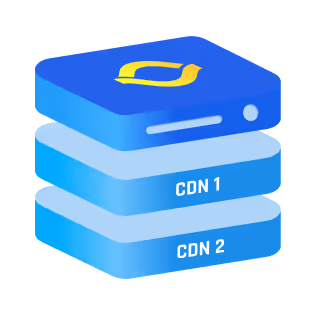Let’s say you’re paying for internet at your data center, and the monthly bill lands in your inbox. But it’s not based on how much total data you moved or a flat fee. Instead, it’s based on something called the 95th percentile. Not sure what that means? You’re not alone.
The network 95th percentile model is one of the most common ways bandwidth usage is billed; especially in enterprise hosting and colocation environments. But if you're not familiar with how it works, it can feel like a trap.
What Does Percentile Mean in Statistics?
Before we touch bandwidth or billing, you need to know what a percentile is.
In simple terms, a percentile shows how a value compares to the rest of the dataset. If you’re in the 95th percentile, that means you scored higher than 95% of others. In contrast, 5% of scores are higher than yours.
You can think of a percentile scale as slicing data into 100 chunks. Each chunk is 1 percentile. Percentiles and quartiles are closely related. Quartiles divide data into 4 parts. Percentiles divide it into 100.
What Is the Network 95th Percentile?
Now let’s zoom back into networking.
The network 95th percentile is a billing method used by ISPs and data centers to charge for bandwidth. It works like this:
- Your bandwidth usage is measured every 5 minutes over a billing cycle (usually a month)
- That gives you around 8,640 samples (12 per hour × 24 hours × ~30 days)
- All those samples are sorted from lowest to highest
- The top 5 percent of those numbers are thrown away
- The highest value left after removing the top 5 percent is your percentile rate
So if you had a few big traffic spikes during the month, they won't be counted; as long as they fall into the top 5 percent. That’s why many call this a “burstable billing” method.
You’re not charged for your very worst traffic moments, just your typical peak.
{{cool-component}}
What Is 95th Percentile Billing?
Let’s say your provider offers 1 Gbps of bandwidth, but charges you based on your 95th percentile billing rate.
Here’s what they’re doing:
- Measuring traffic every 5 minutes
- Sorting those values
- Dropping the top 5 percent (roughly 432 out of 8,640 samples)
- Taking the next highest value, and that becomes your billed rate
If that value is 700 Mbps, you’ll pay as if you used 700 Mbps all month, even if your average was lower.
This method lets you burst above 700 Mbps occasionally without getting penalized, as long as it doesn’t happen too often.
Why Use the Percentile Scale Instead of Averages?
Because averages lie.
If you average 300 Mbps but hit 900 Mbps for long stretches, the average doesn’t reflect your real-world network load.
And if you bill based on peak traffic, a single spike could wreck your budget.
The percentile scale sits comfortably between those two:
- It ignores rare, short bursts
- But it still holds you accountable for sustained high usage
That’s why 95th percentile billing has become a go-to model in network contracts.
Case Example: How Billing Changes With Spikes
Let’s say you’re pushing traffic from your servers throughout the day.
Here’s what your usage looks like over 24 hours:
- 20 hours at 600 Mbps
- 4 hours at 950 Mbps
If your provider billed based on peak, you'd be charged for 950 Mbps, no matter how short those spikes were.
If they billed based on average, it would come out to around 683 Mbps:
(600 × 20 hours + 950 × 4 hours) ÷ 24 hours = 683 Mbps
But with 95th percentile billing, those top 5 percent of samples; maybe those 4 hours at 950 Mbps, could get dropped. That leaves your billed rate closer to 600–650 Mbps, depending on how many spikes and how long they lasted.
You get some breathing room for heavy loads, as long as they don’t happen too often.
What’s a Good 95th Percentile Rate?
This depends on your use case.
If you stream video or serve lots of web traffic, your percentile rate should stay within your plan’s commit level most of the time. A good rate is one that:
- Leaves room for occasional spikes
- Doesn’t consistently exceed your commit
- Doesn’t waste money on unused capacity
Watch your usage over time. If you’re constantly just under a higher billing tier, it may be worth upgrading to avoid penalties when spikes do happen.
How to Check Your 95th Percentile Bandwidth
If you're running your own infrastructure or VPS, you’ll need to collect traffic data and calculate it yourself or use built-in monitoring.
Tools and methods include:
- NetFlow / sFlow / IPFIX exports
- SNMP graphs from switches or routers
- RRDtool, Cacti, or Grafana dashboards
- Some providers give you the graph directly
Once you’ve got the 5-minute intervals, just sort them and drop the top 5 percent. The highest remaining value is your 95th percentile bandwidth.
95th Percentile vs. Other Billing Models
Here’s how 95th percentile billing compares with other methods:
Tips to Lower Your Percentile Rate
If you're getting hit with a high percentile rate, you can reduce your bill by controlling when and how you send traffic.
Here’s what helps:
- Spread out large transfers instead of sending them all at once
- Schedule backups during off-peak hours
- Use traffic shaping or rate limiting to control spikes
- Compress your data to reduce outbound load
The trick is to stay under the spike threshold as much as possible. If you can shave off those high bursts, your 95th percentile drops.
{{cool-component}}
Common Mistakes People Make
- Relying on averages: Average usage means nothing on a percentile billing model
- Ignoring bursts: If your application occasionally goes wild, you’ll pay for it
- Not monitoring properly: If you don't know what your traffic looks like, you can't manage it
It’s worth setting up graphs or alerts that track your 95th percentile usage in real time.
How Providers Use 95th Percentile Internally
It’s not just you paying this way. Most data centers and ISPs use 95th percentile billing behind the scenes too.
When they buy bandwidth from upstream carriers, they’re usually billed using the same model. That means the providers themselves need to watch their own traffic patterns closely, just like you do.
By applying 95th percentile rules to customers, they:
- Keep things fair across the board
- Avoid passing on every random traffic spike
- Get a predictable, scalable billing structure for both directions of traffic
In short, the percentile rate is also how network capacity is managed and scaled across the internet.
Conclusion
The network 95th percentile might sound intimidating at first, but it’s just a smarter way to handle bandwidth billing. It gives you room to breathe, lets you burst occasionally, and rewards consistent network behavior.



.png)
.png)
.png)






